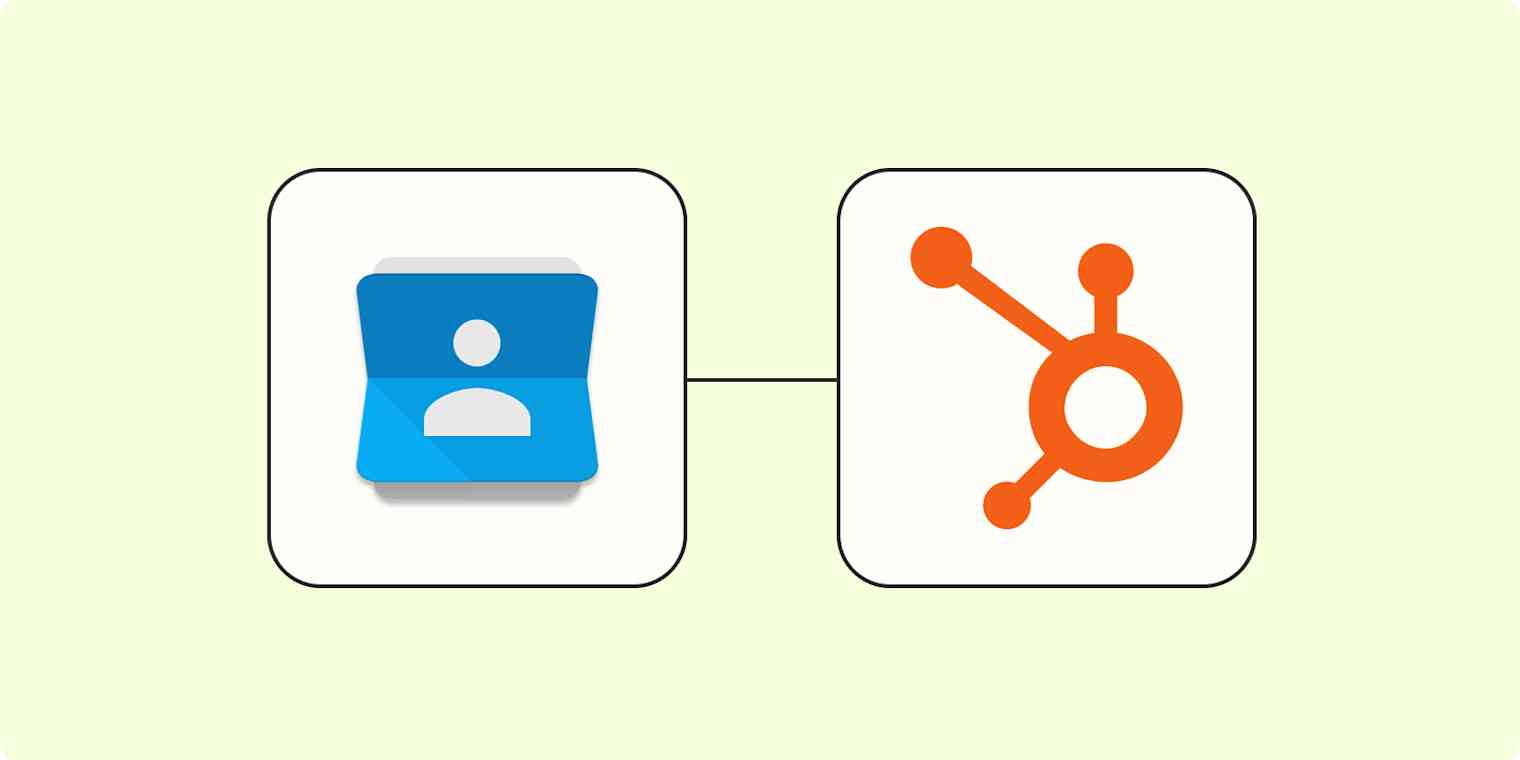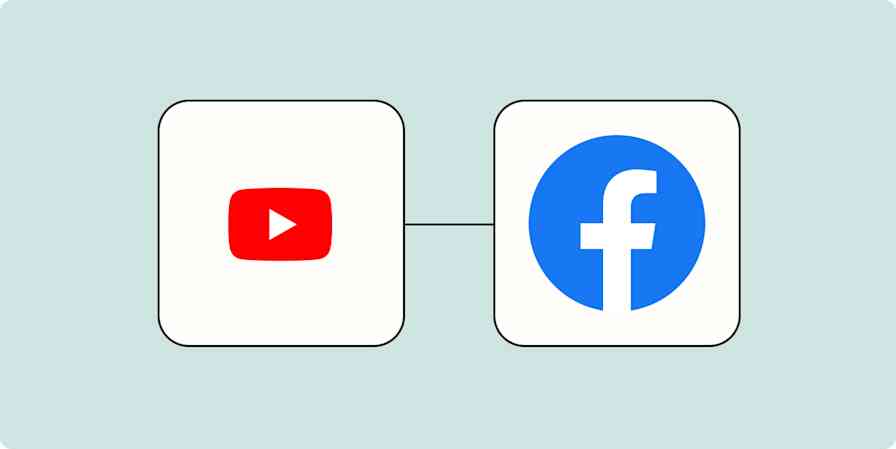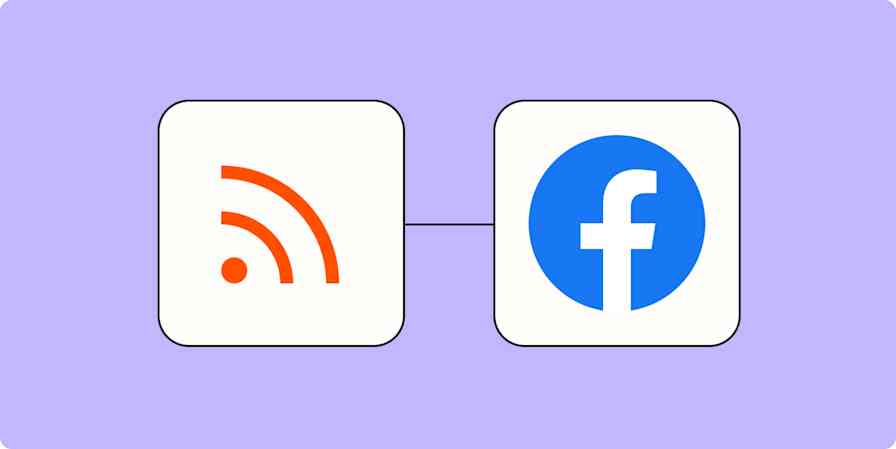Want to send customized messages to leads? Of course you do, because personalized messages elicit higher conversion rates. But tailored outreach requires accurate, up-to-date lead information—and manually keeping your data updated across apps doesn't scale.
With automation, you can send information from one app to another without manual data entry. In this tutorial, we'll show you how to set up a Zap—our word for automated workflow—that instantly adds or updates a HubSpot contact when a contact gets updated in Google Contacts. That way, your lead information gets updated in real time in the right apps, allowing you to send customized messages at scale.
This workflow requires a multi-step Zap, available on a paid Zapier plan or during a free trial. Learn more about multi-step Zaps.
Before you begin
If you haven't already connected your HubSpot account to Zapier, you'll need administrator privileges to set it up. Check your HubSpot settings to verify your permission level—and reach out to the right person on your team if needed.
Also, if you're new to search actions, this tutorial will be a gentle intro. Search actions help update existing data in your apps and prevent duplicate records.
How to connect Google Contacts and HubSpot
Zapier lets you create automated workflows called Zaps, which send your information from one app to another. You can create your own Zap from scratch without any coding knowledge, but we also offer quick templates to get you started.
If you'd like to start with a template, click on the Zap template below, and you'll be taken to the Zap editor. You'll need to create a Zapier account if you don't already have one. Then, follow the directions below to set up your Zap.
Create or update contacts in HubSpot for new or updated Google Contacts
Set up your Google Contacts trigger
First, set up your trigger—the event that starts a Zap.
If you're creating a Zap from scratch, select Google Contacts as the app, New or Updated Contact as your Event, and click Continue. (If you're using our Zap template, this part will already be set up for you.)

Next, connect your Google Contacts account to Zapier. If you haven't connected Google Contacts to Zapier before, sign into your Google account when prompted. Otherwise, select your Google Contacts account from the dropdown menu and click Continue.
Then, test your trigger. Zapier will look for a recent contact in the Google Contacts account you just connected. You'll use whatever Zapier finds to set up the rest of your Zap.
Once you see a success message, check the results and ensure you have the data you want. If something looks off, adjust your trigger criteria and retest until you get the right information.
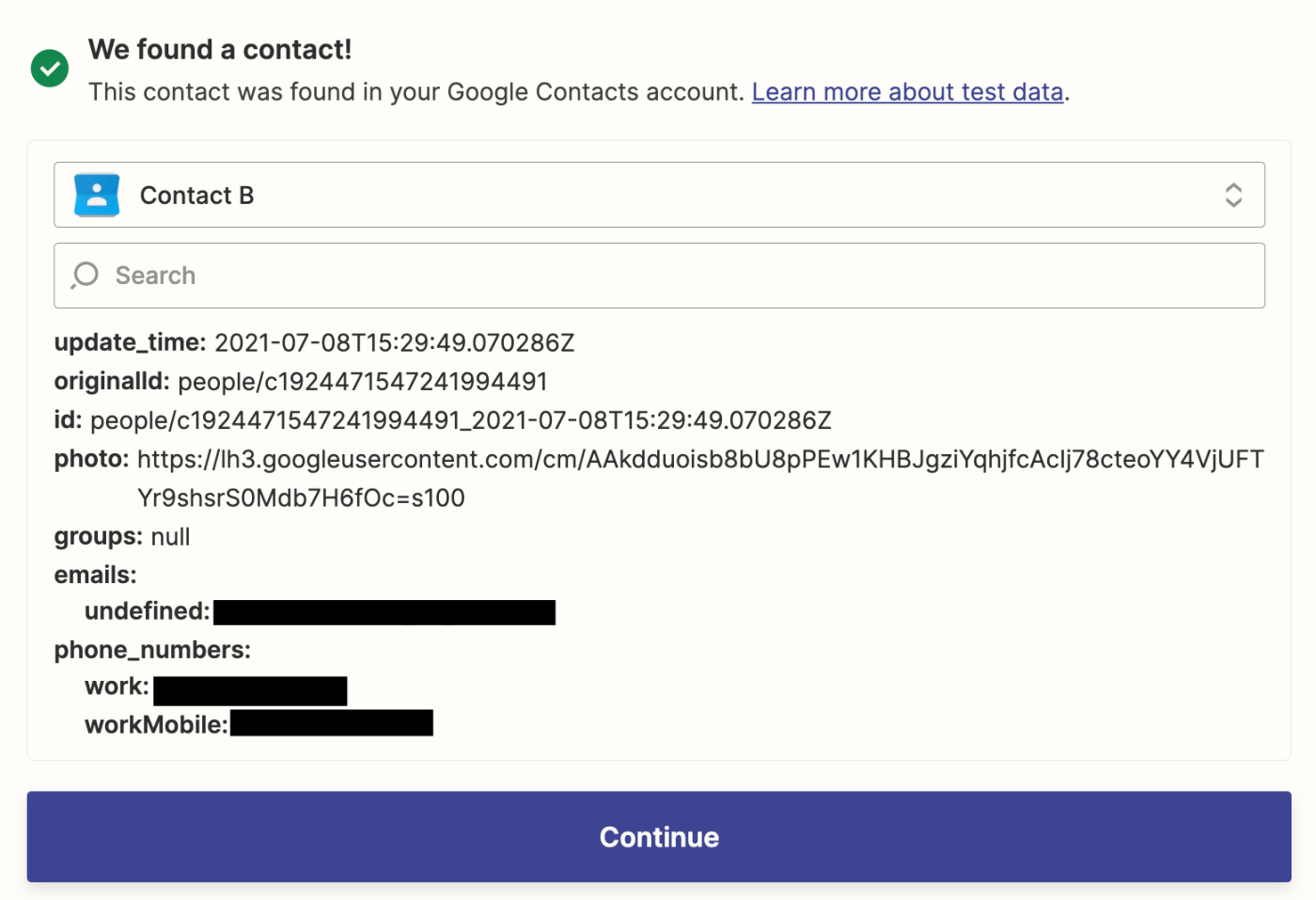
Once you're happy with the results, click Continue.
Set up your HubSpot search action
Next, we'll set up our first HubSpot action step—which will check for existing HubSpot contacts that match the Google Contact sample the previous trigger step found.
Check out our guide on how to get the most out of Zapier search steps.
If you're creating a Zap from scratch, search for and select HubSpot as your app, Find Contact as your event, and click Continue. (The Zap editor will do this for you if you're using our Zap template.)
Next, connect your HubSpot account or select an existing HubSpot account from the dropdown and click Continue.
Now you need to specify what you want Zapier to look for within your HubSpot contacts. Click on the dropdown beneath First search property value, then select the HubSpot contact property (such as email or phone number) you want your search to focus on.
Pro-tip: It's easier to pick a contact property that's less prone to human error, such as an email address. For example, if you're gathering leads from forms or newsletter signups, the chances are low that the lead will enter their email address incorrectly.
Once you've selected your HubSpot contact property, Zapier will ask for a search value, which is the information your Zap will match across apps. To pass information from your Google Contacts to HubSpot, you must map a dynamic value to the First search property value field. Click the dropdown and select the corresponding field from your Google Contact trigger.

In our example, we want HubSpot to look at the email address of our contacts in Google Contacts. We've selected email in the First search property name field, then made sure to select the email address found in our Google Contacts trigger step in the first search property value field.
HubSpot gives you the option to set backup properties and values to search in case your first search fails. If you'd like to set this up, repeat the steps above to set up your backup search properties.
If you're using our Zap template, you'll notice that Create HubSpot Contact if it doesn't exist yet? is checked.

Certain apps, like HubSpot, allow you to search for existing data and create new items in the same step, which saves you setup time.
Since this option is checked, the Zap editor will prompt you to customize what you want in your new contact record.
Note: A new contact record will only be created if there's no matching email found. Otherwise, this Zap will continue onto the next step.
To pass information from Google Contacts to HubSpot, map fields from your Google Contacts trigger to the corresponding HubSpot contact properties.
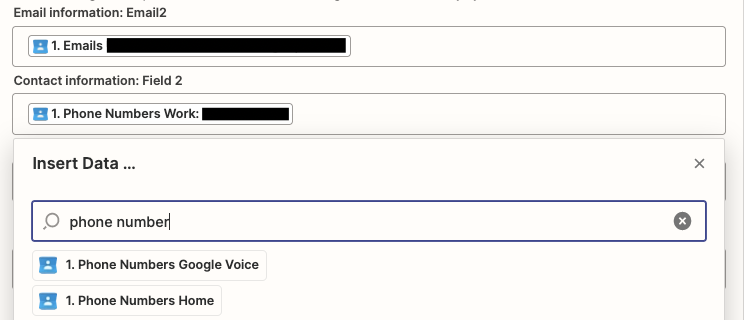
Note: These fields are customized based on the fields you have set up in each account. You don't need to fill out every field listed in the Zap editor—just the ones you need.
Once you've customized what will go in your new contact record, click Continue.
Now test your search action. Zapier will search for an existing HubSpot contact. When you see a success message, check your test data carefully. If Zapier found a HubSpot contact that matches the test data in Google Contacts, _zap_data_was_found will be true, and that contact will be updated. If Zapier finds nothing, this will be false, and a new contact record will be created and then updated.
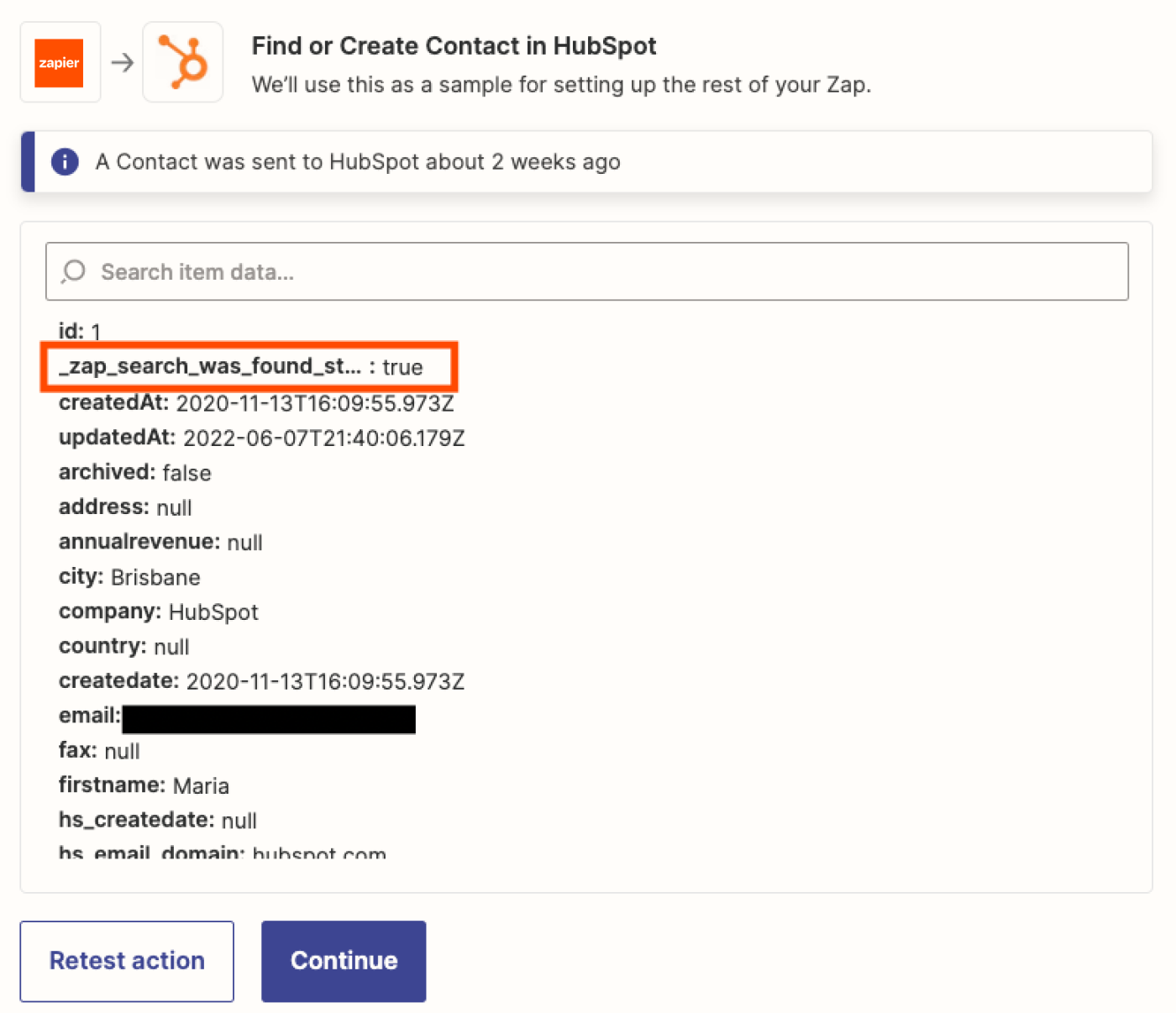
Click Continue.
Set up your filter step
If your _zap_data_was_found is true, the Zap will continue onto this step—which filters your existing HubSpot contacts, so they can be updated correctly. If your _zap_data_was_found is false, a new HubSpot contact will be created. If you're using our Zap template, a filter step will already be set up for you.
If you're setting up this Zap from scratch, choose Filter by Zapier as your action app.

Then, set up your filter by selecting Zap Search Was Found Status from the Choose field dropdown and (Boolean) Is true from the Choose condition dropdown.
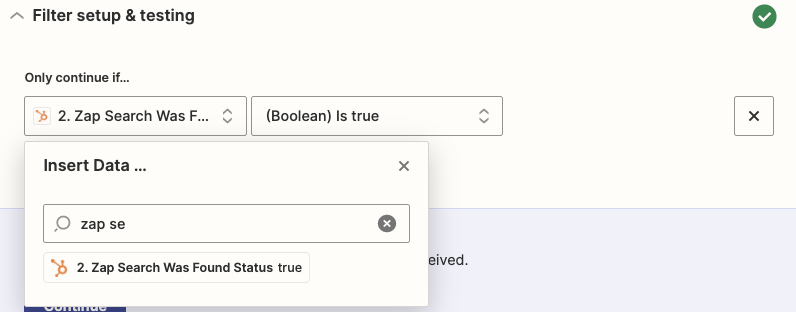
When you're ready, click Continue to test your filter. If your filter behaves how you expected it to, click Continue again. If you still need to, adjust your filters and retest until you get the expected result.

Set up your second HubSpot action step
Now you'll set up the final step in this Zap. If Zapier finds an existing contact in HubSpot, this action will update that contact record.
If you're creating this Zap from scratch, search for and select HubSpot as your action app, Update Contact as your action event, and click Continue.
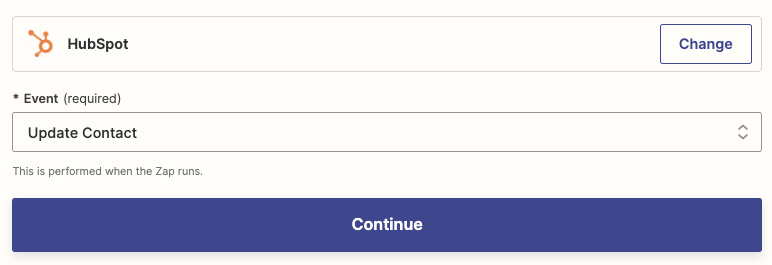
Next, select your HubSpot account from the dropdown menu and click Continue.
The Zap editor will prompt you for an Object ID. This is the piece of information Zapier uses to identify which HubSpot contact to update. Click in the Object ID field and choose the correct ID field from HubSpot in the dropdown.
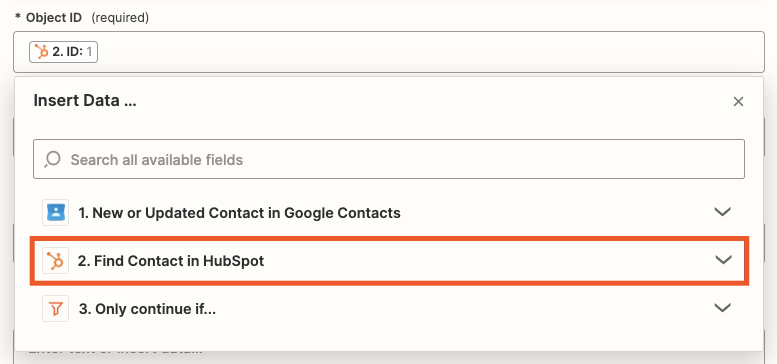
Now you can customize the rest of this step according to the contact properties you want to update in HubSpot. When you're done, click Continue.
Finally, test your update action.
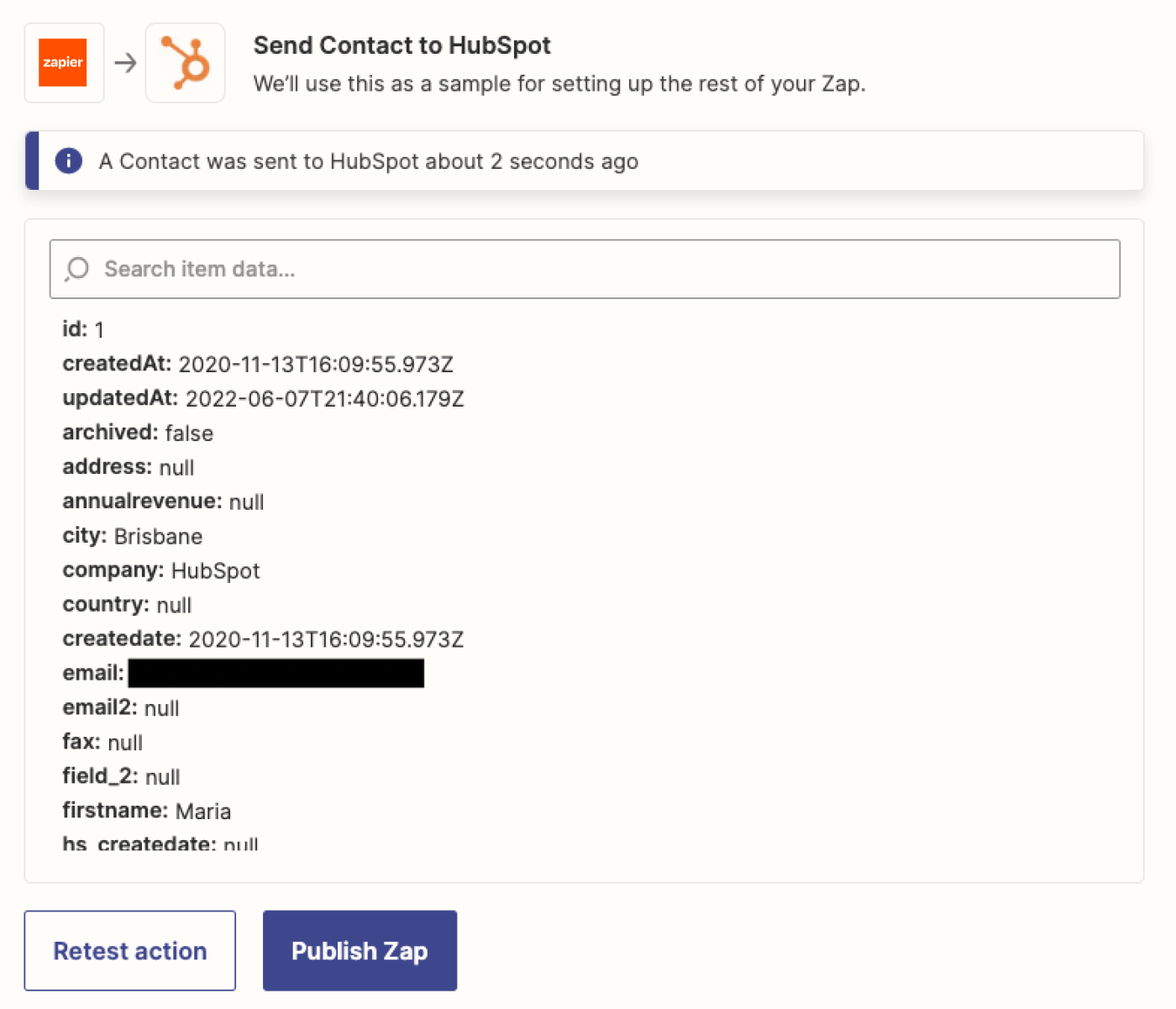
Testing this step will update an existing contact in HubSpot. We recommend using dummy customer info in your sample data, or you can click Skip test if you don't want to add test contacts to your account (though testing your Zap is always a good idea to ensure it's working correctly). If you test your action and see a success message, check your HubSpot account and verify that your information passed through correctly.
Then you're ready to use your Zap.
Update your HubSpot data for better outreach
Save time, avoid duplicate entries, and enrich your lead data by automatically sending Google Contacts to HubSpot. Now, your HubSpot lead data will be updated in real time, so you can scale your personalized lead outreach—without sacrificing speed.
Try it for yourself with our Zap template:
